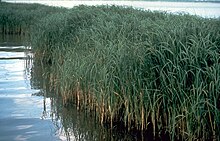Sporobolus alterniflorus
| Sporobolus alterniflorus | |
|---|---|

| |
| Scientific classification | |
| Kingdom: | Plantae |
| Clade: | Tracheophytes |
| Clade: | Angiosperms |
| Clade: | Monocots |
| Clade: | Commelinids |
| Order: | Poales |
| Family: | Poaceae |
| Genus: | Sporobolus |
| Species: | S. alterniflorus
|
| Binomial name | |
| Sporobolus alterniflorus (
Loisel.) P.M.Peterson & Saarela | |
| Synonyms | |
|
List
| |
Sporobolus alterniflorus, or synonymously known as Spartina alterniflora, the smooth cordgrass,
S. alterniflorus is noted for its capacity to act as an environmental engineer. It grows out into the water at the seaward edge of a salt marsh, and accumulates sediment and enables other habitat-engineering species, such as mussels, to settle. This accumulation of sediment and other substrate-building species gradually builds up the level of the land at the seaward edge, and other, higher-marsh species move onto the new land. As the marsh accretes, S. alterniflorus moves still further out to form a new edge. S. alterniflorus grows in tallest forms at the outermost edge of a given marsh, displaying shorter morphologies up onto the landward side of the Sporobolus belt.
S. alterniflorus is native to the Atlantic coast of the Americas from Newfoundland, Canada, south to northern Argentina, where it forms a dominant part of brackish coastal saltmarshes.
The
Problems as an invasive species
Sporobolus alterniflorus can become an
One example of an invasive Sporobolus alterniflorus hybrid is that of
The world's largest invasion of Sporobolus alterniflorus is in China, where plants from multiple North American locations were intentionally planted starting in 1979 with the intention of providing shore protection and sediment capture. The invasion has spread to over 34,000 hectares in ten provinces and Hong Kong.[7]
In Willapa Bay of Washington state, Sporobolus alterniflorus was probably an accidental introduction during oyster transplants during the nineteenth century and may have dispersed from there to other parts of the state. At its peak of infestation in 2003, it covered approximately 3,000 hectares (more than 8,500 acres), spread across an area of 8,000 hectares (20,000 acres). As of 2016, the infestation had been reduced to less than 3 solid hectares (7 acres).[8]
In
Sporobolus alterniflorus has also been found to hybridize with S. foliosa, producing offspring Sporobolus alterniflorus × S. foliosa that may be an even greater threat than S. alterniflorus by itself.
Several means of control and eradication have been employed against Sporobolus alterniflorus where it has become a pest. Hand pulling is ineffective because even small rhizome fragments that inevitably break off and get left in the soil are capable of sending up new shoots. Imazapyr, an herbicide, is approved for aquatic use and is used effectively in Washington and California to kill it. In Willapa Bay, leafhopper bugs (Prokelisia marginata) were employed to kill the plants, which threaten the oyster industry there, but this method did not contain the invasion. Surveys by air, land, and sea are conducted in infested and threatened areas near San Francisco to determine the spread of Sporobolus species.
References
- ^ USDA, NRCS (n.d.). "Spartina alterniflora". The PLANTS Database (plants.usda.gov). Greensboro, North Carolina: National Plant Data Team. Retrieved 24 November 2015.
- doi:10.12705/636.19.
- PMID 31398280.
- ^ http://www.fs.fed.us/database/feis/plants/graminoid/spaalt/all.html USDA Forest Service Fire Effects Information System (FEIS) for Spartina alterniflora
- ^ Lippson, AJ & RL Lippson. 2006. Life in the Chesapeake Bay, 3rd ed., p.295. Johns Hopkins Press.
- ^ http://plants.usda.gov/java/profile?symbol=spal USDA NRCS PLANTS profile for Spartina alterniflora
- S2CID 85651095.
- ^ https://agr.wa.gov/plantsinsects/weeds/spartina/default.aspx, Washington State Department of Agriculture Spartina Eradication Annual Reports. Accessed 7/12/18.
- ^ S2CID 24732543.
- S2CID 86778195.
- S2CID 32865913.
- S2CID 43049200.
- S2CID 14283700.
- ^ Verge (August 7, 2018). "This monster plant is trying to take over. What if we let it?". YouTube. Archived from the original on 2021-12-21. Retrieved 24 December 2020.
